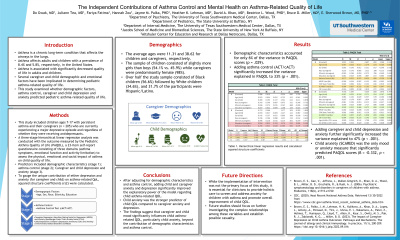Child and Adolescent Psychiatry
Session: Poster Session
(032) Contribution of Caregiver and Child Anxiety and Depressive Symptoms to Child Asthma-related Quality of Life

Trainee Involvement: Yes
- DG
Do Young Gwak, MD
CL - Attending
UTSW
Dallas, Texas, United States - JT
Juliann C. Tea, M.D.
Consultation-Liaison Psychiatry Fellow
The University of Texas Southwestern Medical Center
Dallas, Texas, United States - FF
Fariya N. Fatima, n/a
Medical Student
UT Southwestern Medical Center
Dallas, Texas, United States - HZ
Hannah Zhou, n/a
student
UT Southwestern
Dallas, Texas, United States - JP
Jayme M. Palka, PhD
Assistant Professor of Psychiatry; Biostatistician
UT Southwestern Medical Center
Dallas, Texas, United States - HL
Heather Lehman, MD
Clinical Associate Professor of Pediatrics
University of Buffalo Jacobs School of Medicine and Biomedical Sciences
Buffalo, New York, United States - DK
David Khan, MD
Professor of Medicine
UT Southwestern
Dallas, Texas, United States - BW
Beatrice L. Wood, PhD, ABPP
Professor of Psychiatry and Pediatrics,
Jacobs School of Medicine and Biomedical Sciences
Buffalo, New York, United States - BM
Bruce D. Miller, MD
Professor, With Tenure, of Psychiatry and Pediatrics
Jacobs School of Medicine and Biomedical Sciences, University at Buffalo
Buffalo, New York, United States .jpg)
E. Sherwood Brown, MD, PhD, FACLP, DLFAPA
Vice Chair for Clinical Research, Department of Psychiatry
The University of Texas Southwestern Medical Center
Dallas, Texas, United States
Presenting Author(s)
Co-Author(s)
References Brown, E. S., Gan, V., Jeffress, J., Mullen-Gingrich, K., Khan, D. A., Wood, B. L., Miller, B. D., Gruchalla, R., & Rush, A. J. (2006). Psychiatric symptomatology and disorders in caregivers of children with asthma. Pediatrics, 118(6), e1715-e1720 Wood, B. L., Brown, E. S., Lehman, H. K., Khan, D. A., Lee, M. J., & Miller, B. D. (2018). The effects of caregiver depression on childhood asthma: Pathways and mechanisms. Annals of Allergy, Asthma & Immunology, 121(4), 421-427. https://doi.org/10.1016/j.anai.2018.06.031
Background: Asthma is a common, chronic condition of the airways in the lungs affecting 8.4% of adults and 5.8% of children in the United States. When present, asthma is associated with decreases in asthma-related quality of life (QOL) in adults and children. Caregiver and child demographic and emotional factors may influence pediatric asthma-related QOL (Brown et al., 2006, Wood et al., 2018). We examined whether caregiver and child depression and anxiety uniquely predict pediatric asthma-related QOL above and beyond demographic characteristics and asthma control.
Method: Included were children ages 7-17 with persistent asthma and their caregivers (n = 205) who were experiencing a major depressive episode. Three-stage hierarchical linear regression analysis was conducted to assess the effects of demographics, asthma control, and depressive and anxiety symptoms on the Pediatric Asthma Quality of Life (PAQOL) scale – a 23-item self-report that assesses the impact of asthma on child QOL. Stage 1 predictors included child’s sex and age, and caregiver’s race, ethnicity, and education. Asthma control – assessed by the Asthma Control Test (cACT for ages 4-11; ACT for ages 12 and older) – was added in stage 2. In stage 3, caregiver depression (Hamilton Rating Scale for Depression [HRSD]) and anxiety (Spielberger State/Trait Anxiety Scale [STAI]), and child depression (Children’s Depression Inventory [CDI]) and anxiety (Screen for Child Anxiety Related Disorders [SCARED]) were added. The unique contribution of both caregiver and child depression and anxiety on the variance explained in asthma-related QOL was determined using squared structure coefficients (rs2).
Results: On average, children and caregivers were 11 and 39 years old, respectively, and were primarily female (54% and 98%, respectively). Fifty-seven percent of children identified as Black, 35% as White, and 32% as Hispanic/Latino. Demographic characteristics accounted for only 6% of the variance in PAQOL scores (p = .029). Adding asthma control (ACT/cACT) significantly increased the variance explained in PAQOL to 33% (p < .001). Adding caregiver and child depression and anxiety further significantly increased the variance explained to 47% (p < .001). Child anxiety (SCARED) was the only mood or anxiety measure that significantly predicted PAQOL scores (β = -0.332, p < .001).
Conclusion: After adjusting for demographic characteristics and asthma control, adding child and caregiver anxiety and depression significantly improved the explanatory power of the model regarding child asthma-related QOL. Child anxiety was the only significant anxiety and depression predictor of child QOL. The findings suggest that caregiver and child mood significantly influences child asthma-related QOL, particularly child anxiety, beyond the contribution of demographic characteristics and asthma control.

